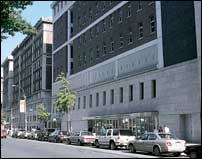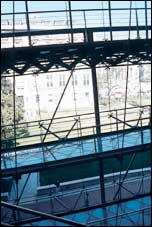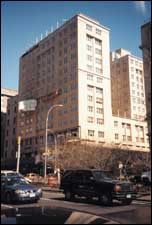 |
 |
 |
 |
|
COVER STORY
Columbia's two most recent buildings, Alfred Lerner Hall and the Broadway Residence Hall (which opened in 1999 and 2000, respectively), reaffirm the University's connection with New York City. Although the buildings differ in important ways, they share an urban outlook and demonstrate a goal of George Rupp's presidency: to strengthen and enrich the University's relationship with the community. Both buildings were designed by world-class architects who understand Columbia's traditions and aspirations. Lerner Hall is the work of Bernard Tschumi, dean of the School of Architecture, Preservation and Planning. The Broadway dormitory was designed by Robert A.M. Stern '60, a former Columbia faculty member who is now the dean of the School of Architecture at Yale. Part of their architectural challenge was to make buildings that conveyed the identity of the University while responding to the streetscape and urban context, buildings about Columbia and the City of New York. Lerner Hall has two distinct faces: a stone and brick building faces Broadway, and a lower block with a spellbinding glass wall is oriented to the campus. Lerner Hall has an important urbanistic job because it is the first central campus building visible from a southern approach. Lerner forms part of the Broadway elevation of the campus that runs from 114th to 120th Street, and it declares its University affiliation by adopting the materials, proportions and architectural features of the buildings to the north. The pink granite base and top story of stone, the moldings, cornice and roof line — all these elements are repeated at Lerner, but with a telling change. The Broadway façade of Lerner does not produce the fortress effect of its Columbia neighbors. Instead of an impenetrable base punctuated by grated windows, as in Furnald, Lerner Hall features a series of glass doors leading to Roone Arledge Auditorium and the University bookstore, where pedestrians also have an inviting view of the atrium inside the hall. The use of glass at street level as well as in the third floor — Tschumi wittily used glass brick instead of limestone in this zone — hints at the importance of glass, which is fully visible on the campus side. Pass through the Broadway gate and a different aspect of Lerner comes into view. A stunning wall of glass dominates the ramped walkway and affords one of the genuine architectural pleasures of the campus. From the walkway you can observe the beautifully detailed structure of the truss, cantilevered support arms and X-shaped brackets that hold the glass plates in place; the spatial volume of the atrium where ceiling windows reveal patches of sky; the dynamic pattern of the aerial ramps which seem like extensions of the ramp you ascend outside the building; and, of course, the shifting patterns of people on the move. In daylight, the glass wall is transparent and invites you to look inside, but at night, in a marvelous reversal, the blue lights of the ramps draw attention to the substance and supporting structures of the wall. Lerner Hall becomes our Times Square.
The atrium is the pulsating heart of Lerner, a great volume of space that rises five floors. The atrium is designed for viewing. The ramps and walkways offer a seemingly infinite number of views through the space, into flanking rooms — restaurants, auditorium, seminar and activity rooms — and out, across the campus. These intriguing views are another distinctive pleasure. My favorite is the panorama of the South Lawn and Low Library seen on the diagonal and through the gridded pattern of the glass wall, an overlay that evokes for me the energizing tension between city and University. The atrium of Lerner is also about movement. Circulation is not boxed into a stairwell; it is on display. Lerner Hall captures and sustains on its interior walkways and diagonal ramps the energy and movement of Broadway, New York's boldest diagonal. The scene is always changing, like the activity banners on display or the students checking in at the 6,000 mailboxes. Lerner Hall celebrates movement and the intrigue of looking, and fuses the pulse of student life with that of New York City. It is a quintessentially urban building. The Broadway dormitory rises a block to the south, at the corner of 113th Street, and like Lerner, it has two distinct faces. The Broadway façade resembles apartment buildings in the area and pertains to the patterns of the avenue, whereas the 113th Street side expresses something of collegiate life in the dorm. It is instructive to compare the new dormitory with Hogan Hall, the adjacent 1898 building that was not originally a dorm. Hogan Hall is set back from the building line, and a flight of steps lifts the main entrance above street level. The building literally withdraws from the street, whereas the Broadway dormitory participates in the culture of the avenue. Designed with shop fronts along Broadway, the building contains retail space (occupied by a video store) and a branch of the New York Public Library. The University has had a long-standing relationship with the New York Public Library dating back to 1937, when the Morningside branch was installed on 114th Street in the back of Butler Library. The facilities in the Broadway dormitory significantly expand the library's resources. It has 17,000 square feet, 10 times the area of its nook on 114th Street, and includes meeting space available to the public. Finally, the Broadway location gives the library greater prominence in the neighborhood it serves.
The collegiate functions of the dormitory are revealed on 113th Street, where the 14-story building is shaped like a U. The side wings contain the dorm rooms; there are 371 beds in the building. The middle section, which is set back from the side street, contains elevators, kitchens and lounges on every floor. The layout provides wonderful southern views of New York City from the moment the elevator doors open, but also visually connects the wings of the dorm to the center where communal activities take place. Although the building is visually oriented to 113th Street, circulation moves in the opposite direction. There is no access to 113th Street; students enter the dormitory from 114th Street, through a handsome doorway opposite the Carman gate. The entry corridor and lounge, which extend midway through the block, are cleverly inserted behind Hogan Hall with passageways opened up between the buildings. The Broadway dormitory, Hogan and nearby Watt were conceived as a senior residence center, and the Senior Class Center is located on the ground floor of the new residence hall. The Broadway dormitory reflects community concerns in another, more significant way. During the design process, the University solicited the reactions of community representatives. In response to their concerns, Stern made three key changes in his scheme. First, the height of the building was reduced from 21 to 14 stories, the prevailing height on this part of Broadway. Second, the color of brick was changed from Columbia's characteristic red to tan, so that the building would blend with its surroundings. Third, the University preserved the façade of a townhouse on 113th Street designed by George Keister in 1903 — the Sigma Chi fraternity house where Lou Gehrig '25 once lived. Although the finest designs are not produced by committee, the working process associated with the Broadway dormitory is a meaningful achievement. Some critics may fret about the whimsical gazebo on the roof or the fake balustrades over brick walls; they may lament the treatment of the townhouse façade, which survives as a relic, detached from the building it once adorned. But it is more important, at this point in time, that the Broadway dormitory has initiated a new era of collaboration between Columbia and the Morningside neighborhood.
|
|
||||||||||||||||||||||||||||||||||||||||||||||||||||||||||||||||||||||||||||||


